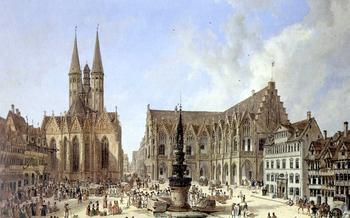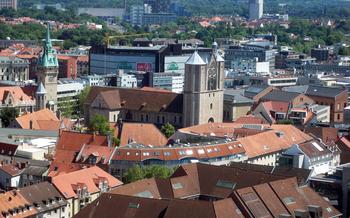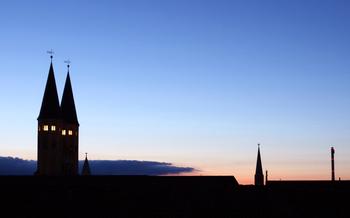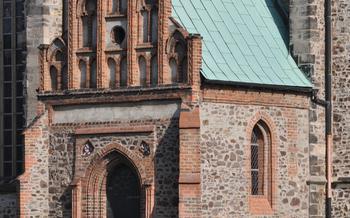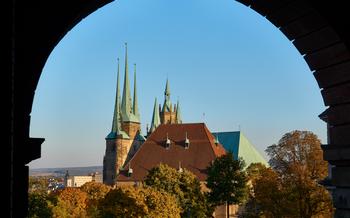
Naturschutzgebiet Riddagshausen (Nature Reserve)
- Naturschutzgebiet Riddagshausen
- Flora and Fauna of the Naturschutzgebiet Riddagshausen
- Trails and Paths in the Naturschutzgebiet Riddagshausen
- Guided Tours of the Naturschutzgebiet Riddagshausen
- Things to Do in the Naturschutzgebiet Riddagshausen
- Visitor Center of the Naturschutzgebiet Riddagshausen
- Accessibility of the Naturschutzgebiet Riddagshausen
- Tips for Visiting the Naturschutzgebiet Riddagshausen
- History of the Riddagshausen Abbey
- Architecture of the Riddagshausen Abbey
- The Riddagshausen Abbey Today
- Legends and Stories of the Riddagshausen Abbey
- The Riddagshausen Abbey Museum
- Accessibility of the Riddagshausen Abbey
- Insider Tip
Naturschutzgebiet Riddagshausen
History of the Naturschutzgebiet Riddagshausen
The Naturschutzgebiet Riddagshausen, also known as the Riddagshausen Nature Reserve, is a beautiful and diverse natural area located in the city of Braunschweig, Germany. The nature reserve was established in 1940 to protect the unique flora and fauna of the area. It is home to a variety of plant and animal species, including many that are endangered. The nature reserve also plays an important role in the conservation of water resources and in providing a habitat for migratory birds.
The Naturschutzgebiet Riddagshausen was established through the efforts of a group of local citizens who were concerned about the destruction of the area's natural resources. They worked together to raise awareness of the importance of the area and to convince the government to protect it. In 1940, their efforts were successful, and the Naturschutzgebiet Riddagshausen was established. The nature reserve has since been expanded several times, and it now covers an area of over 500 hectares.
The Naturschutzgebiet Riddagshausen is an important natural area that provides a home to a variety of plant and animal species. It also plays an important role in the conservation of water resources and in providing a habitat for migratory birds. The nature reserve is open to the public, and visitors can enjoy a variety of activities, including hiking, biking, and bird watching.
Flora and Fauna of the Naturschutzgebiet Riddagshausen
The Naturschutzgebiet Riddagshausen is home to a diverse array of plant and animal life. The reserve's forests are dominated by beech and oak trees, which provide a habitat for a variety of birds, including woodpeckers, nuthatches, and tits. The reserve's meadows are home to a variety of wildflowers, including orchids, buttercups, and daisies, which attract a variety of butterflies and bees. The reserve's ponds and streams are home to a variety of fish, amphibians, and reptiles, including frogs, toads, and newts.
The Naturschutzgebiet Riddagshausen is also home to a number of rare and endangered species. The reserve is home to the only known population of the Riddagshausen long-horned beetle, a rare beetle that is found nowhere else in the world. The reserve is also home to a number of rare and endangered bird species, including the European bee-eater, the European roller, and the Eurasian wryneck.
The Naturschutzgebiet Riddagshausen plays an important role in the conservation of endangered species. The reserve provides a safe haven for these species, and the reserve's management practices are designed to protect and enhance their habitats. The reserve also plays an important role in raising awareness of the importance of biodiversity and conservation.
Trails and Paths in the Naturschutzgebiet Riddagshausen
The Naturschutzgebiet Riddagshausen offers a variety of trails and paths that visitors can explore, ranging from easy walks to challenging hikes. The Hauptweg, or main trail, is a 5-kilometer loop that takes visitors through the heart of the nature reserve, passing by the Riddagshausen Abbey, the Oker River, and the Große Wiese meadow. The Nebenwege, or side trails, offer shorter and more focused walks, allowing visitors to explore specific areas of the nature reserve, such as the beech forest or the heathland.
The trails in the Naturschutzgebiet Riddagshausen are well-marked and easy to follow, making them suitable for visitors of all ages and fitness levels. The Hauptweg takes about two hours to complete, while the Nebenwege can be completed in less than an hour. Visitors can choose to hike the trails on their own or join a guided tour led by a knowledgeable ranger.
The Naturschutzgebiet Riddagshausen is a great place to go for a hike, no matter what your fitness level or interests. The trails offer stunning views of the landscape, and the opportunity to see a variety of plants and animals. So lace up your hiking boots and explore the beauty of the Naturschutzgebiet Riddagshausen!
Guided Tours of the Naturschutzgebiet Riddagshausen
Are there guided tours available?
Yes, guided tours of the Naturschutzgebiet Riddagshausen are available for individuals and groups. These tours are led by experienced naturalists who can provide insights into the area's history, ecology, and conservation efforts.
What do the guided tours include?
Guided tours typically cover the following topics:
- The history of the nature reserve and the Riddagshausen Abbey
- The diverse flora and fauna of the area
- The conservation efforts underway to protect the nature reserve
- The different trails and paths that visitors can explore
How much do the guided tours cost?
The cost of guided tours varies depending on the size of the group and the length of the tour. However, most tours typically range in price from 5 to 15 euros per person.
How to book a guided tour?
Guided tours can be booked in advance by contacting the Naturschutzgebiet Riddagshausen visitor center. It is recommended to book a tour in advance, especially for groups, to ensure availability.
Things to Do in the Naturschutzgebiet Riddagshausen
Visitors to the Naturschutzgebiet Riddagshausen can enjoy a variety of activities, including hiking, biking, birdwatching, and picnicking.
There are several trails and paths that visitors can explore, ranging from easy walks to challenging hikes. The most popular trail is the Riddagshausen Loop Trail, which is a 5-mile loop that takes about 2 hours to complete. The trail winds through the forest, past the abbey, and along the Oker River.
Birdwatching is another popular activity in the nature reserve. There are over 200 species of birds that have been spotted in the area, including woodpeckers, owls, and eagles. The best time for birdwatching is in the spring and fall, when the birds are migrating.
Picnicking is also a great way to enjoy the nature reserve. There are several picnic areas located throughout the park, including a large picnic area near the visitor center. Visitors can bring their own food or purchase food from the café at the visitor center.
Swimming is not allowed in the nature reserve, but there are several swimming pools and lakes nearby where visitors can swim.
Visitor Center of the Naturschutzgebiet Riddagshausen
The visitor center of the Naturschutzgebiet Riddagshausen is a great place to learn about the nature reserve and its unique biodiversity. The center features a variety of exhibits on the plants, animals, and history of the area. There is also a theater where visitors can watch a film about the nature reserve. The visitor center offers a variety of educational programs for all ages, including guided tours, workshops, and lectures. Visitors can also rent bicycles and canoes at the visitor center.
The visitor center is open Tuesday through Sunday from 9 am to 5 pm. Admission is free. The visitor center is located at the entrance to the nature reserve, on the west side of the Oker River. There is plenty of free parking available.
Accessibility of the Naturschutzgebiet Riddagshausen
Getting to the Naturschutzgebiet Riddagshausen is easy and convenient. The nature reserve is located just a short distance from the city center of Braunschweig, making it easily accessible by car, public transportation, or even by foot or bike.
For those traveling by car, there are several parking lots available near the entrances to the nature reserve. Public transportation is also a great option, with several bus lines stopping near the nature reserve. The journey takes around 20 minutes.
For those who prefer to explore the nature reserve on foot or by bike, there are several trails and paths that start from the city center and lead directly into the nature reserve. These trails are well-marked and easy to follow, making them a great option for both experienced and novice hikers and bikers.
Tips for Visiting the Naturschutzgebiet Riddagshausen
What to wear and bring:
When visiting the Naturschutzgebiet Riddagshausen, it is important to wear comfortable clothing and shoes. The trails can be uneven and muddy, so it is advisable to wear hiking boots or sturdy sneakers. It is also important to bring a raincoat or umbrella, as the weather in Braunschweig can be unpredictable. Other essential items to bring include water, snacks, and a camera.
When is the best time to visit:
The best time to visit the Naturschutzgebiet Riddagshausen is during the spring or summer months, when the weather is mild and the flowers are in bloom. However, the nature reserve is also beautiful in the fall, when the leaves change color.
What are the safety precautions that visitors should take:
The Naturschutzgebiet Riddagshausen is a safe place to visit, but there are a few safety precautions that visitors should take. It is important to stay on the marked trails and to be aware of your surroundings. It is also advisable to avoid swimming in the lakes, as there can be strong currents.
History of the Riddagshausen Abbey
The Riddagshausen Abbey was founded in 1145 by Duke Henry the Lion and his wife Matilda of England. The abbey was a Cistercian monastery, and it was one of the most important monasteries in northern Germany. The monks who lived at the abbey were dedicated to a life of prayer and work. They were also responsible for managing the abbey's extensive lands, which included forests, farms, and vineyards.
The abbey played an important role in the community. It provided spiritual guidance and support to the local people, and it also helped to promote economic development in the region. The monks were skilled craftsmen, and they produced a variety of goods that were sold to the surrounding communities. The abbey also ran a hospital, which provided care to the sick and injured.
The Riddagshausen Abbey was dissolved in 1569 during the Protestant Reformation. The abbey's lands were confiscated by the Duke of Brunswick-Lüneburg, and the monks were forced to leave. The abbey buildings were largely destroyed, and only a few ruins remain today.
Architecture of the Riddagshausen Abbey
The Riddagshausen Abbey is a beautiful example of Romanesque architecture. It was built using red bricks and sandstone, and its most striking features are its two towers, which are topped with pointed spires. The abbey also has a large rose window, which is located above the main entrance. The interior of the abbey is equally impressive, with its vaulted ceilings and its many stained glass windows. The abbey has undergone several renovations over the years, but its original Romanesque style has been largely preserved.
The Riddagshausen Abbey Today
The Riddagshausen Abbey has undergone several renovations and restorations throughout its history. The most recent renovation was completed in 2010, which restored the abbey to its former glory. Today, the abbey is a popular tourist destination and a venue for various events, such as concerts, exhibitions, and weddings.
Visitors to the abbey can explore the beautifully preserved cloisters, the impressive chapter house, and the grand refectory. The abbey also houses a museum that tells the story of the abbey's history and its role in the community.
The Riddagshausen Abbey is a living testament to the rich history and cultural heritage of Braunschweig. It is a place of peace and tranquility, where visitors can learn about the past and appreciate the beauty of the natural surroundings.
Legends and Stories of the Riddagshausen Abbey
The Riddagshausen Abbey is steeped in history and legend. One of the most popular legends is the story of the White Lady. According to legend, the White Lady is the ghost of a young woman who was murdered by her lover in the abbey's cloisters. Her ghost is said to haunt the abbey grounds, searching for her lost love.
Another popular legend is the story of the Treasure of the Abbey. According to legend, the monks of the abbey hid a treasure of gold and jewels somewhere on the abbey grounds before the abbey was closed. The treasure has never been found, and many people have searched for it over the years.
The Riddagshausen Abbey has also been visited by a number of famous people over the years. One of the most famous visitors was Emperor Charlemagne, who visited the abbey in 784 AD. Other famous visitors include Martin Luther, who visited the abbey in 1521, and Johann Wolfgang von Goethe, who visited the abbey in 177
The Riddagshausen Abbey is a place of mystery and intrigue. The many legends and stories that are associated with the abbey add to its charm and mystique. Visitors to the abbey can learn more about its history and legends by taking a guided tour or by visiting the abbey museum.
The Riddagshausen Abbey Museum
The Riddagshausen Abbey Museum is a fascinating place that offers visitors a glimpse into the history and culture of the abbey. The museum is housed in the former abbey's stables, which have been beautifully restored to their original glory. Inside the museum, visitors can find a variety of exhibits that tell the story of the abbey, from its humble beginnings to its rise to prominence as one of the most important monasteries in Germany. Visitors can also learn about the daily lives of the monks who lived at the abbey, as well as their role in the community.
The museum has a wide range of exhibits on display, including artifacts from the abbey's history, religious objects, and works of art. The museum also offers a variety of educational programs, such as guided tours, lectures, and workshops. Visitors can learn more about the abbey's history, architecture, and culture through these programs.
The Riddagshausen Abbey Museum is a great place to visit for anyone who is interested in history, culture, or religion. The museum is open to the public from Tuesday to Sunday, from 10am to 5pm. Admission is free.
Accessibility of the Riddagshausen Abbey
The Riddagshausen Abbey is conveniently located and easily accessible by various means of transportation. If you are arriving by car, you can take the A2 motorway and exit at the Braunschweig-Watenbüttel interchange. From there, follow the signs to the abbey. There is ample parking available on-site.
If you prefer to use public transportation, you can take the bus or tram to the Braunschweig Hauptbahnhof (central train station). From there, you can take bus line 414 to the Riddagshausen Abbey stop. The journey takes approximately 20 minutes.
The abbey is also accessible by bike. There are several bike paths that lead to the abbey, making it a popular destination for cyclists. If you are coming from Braunschweig, you can take the Oker bike path, which runs along the Oker River.
No matter how you choose to travel, you will find that the Riddagshausen Abbey is easy to get to and well worth the visit.
Insider Tip
The best way to experience the Naturschutzgebiet Riddagshausen is to take a guided tour. Guided tours are offered by the nature reserve staff and are a great way to learn more about the history, flora, and fauna of the area. Tours are available in German and English and typically last for about two hours.
There are a few hidden gems in the nature reserve that visitors should look for. One is the Riddagshausen Abbey, a former Benedictine monastery that dates back to the 12th century. The abbey is now a museum and is open to the public. Another hidden gem is the Riddagshausen Pond, a beautiful body of water that is home to a variety of wildlife.
Some of the best photo spots in the nature reserve include the Riddagshausen Abbey, the Riddagshausen Pond, and the many hiking trails that wind through the forest. Visitors can also get great photos of the wildlife in the nature reserve, such as deer, foxes, and badgers.

